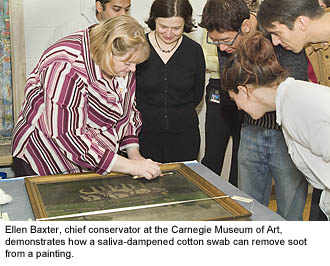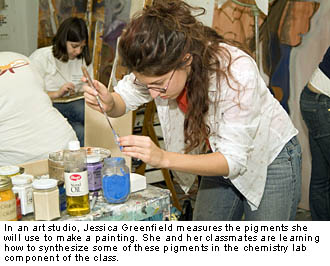A new class at Carnegie Mellon requires artists to don lab coats and chemists to wield brushes.

In the Color of Minerals and Inorganic Pigments course, offered for the first time this fall, students explore the origin of the color using principles of inorganic chemistry. Just as artists did before the advent of mass-produced art materials in the 19th century, students purify and grind minerals in the lab to create their own pigments to use in the studio and then chemically synthesize their own pigments in the lab.
The course—a joint effort between the Mellon College of Science and the School of Art—is different because it brings together in the same classroom senior chemistry and art students for a lesson in interdisciplinary work.
"This class cross-pollinates traditionally disparate disciplines through a lab-centered experience," said Catalina Achim, assistant professor of chemistry and co-creator of the class. "We created this class so that we can reconnect the two disciplines for a study of their common ground: the color of minerals."
Historically, artists visited their local apothecary to get raw materials from which they derived pigments and created paints to use in their artwork. Today's artists buy ready-made paints, which may obscure the synergetic relationship between art and science, according to the course instructors.

Achim and Clayton Merrell, associate professor of art, designed the course to help artists actually use chemistry as they create art. For example, the chemical interaction of pigments could be controlled to create paintings that would change over time. The course also opens the fields of mineralogy and art conservation and restoration to chemists, thus connecting their fundamental science knowledge to real life applications.
"In preparing this class it has struck me how painters and chemists work in similar environments (the laboratory/studio), with similar materials (reagents/solvents chemical compounds/pigments), and even with similar fixation on material process and 'technique' aimed at achieving various types of material transformations," said Merrell. "Color will be the focus of our class because it is one of the most obvious and seductive areas of overlap."
As part of the course, students tour the Hillman Hall of Minerals and Gems at the Carnegie Museum of Natural History, the Research Center on the Materials of the Artist and Conservator at Carnegie Mellon, and the Carnegie Museum of Art, and examine the direct relationship between the materials showcased in the first, analyzed in the second and used in the third. They also visit the Carnegie Museum of Art's Conservation Department, where they see how chemistry is used to treat, preserve and restore works of art.
Guest lecturers include Paul M. Whitmore, director of the Research Center on the Materials of the Artist and Conservator, and Marc Wilson, head of the Hillman Hall of Minerals and Gems. In addition to lecture and laboratory components, the students work collaboratively on hands-on laboratory research projects, which build toward their final project, an exhibition on the Origin of Color to be housed in the University Center on campus.
The course has been enthusiastically received. Art and chemistry students quickly filled the 12 available slots in one day and the waiting list was long. The course and its projects have been designed to expand the expertise of students in both disciplines, while exposing them to the methods, demands and aims of the other.
The class is being supported by the National Science Foundation, the Camille and Henry Dreyfus Foundation, the Department of Chemistry and the Office of the Vice Provost for Education.

The Mellon College of Science at Carnegie Mellon maintains innovative research and educational programs in biological sciences, chemistry, physics, mathematics and several interdisciplinary areas.
The College of Fine Arts is a community of nationally and internationally recognized artists and professionals organized into five schools: Architecture, Art, Design, Drama and Music, and its associated centers and programs.
Related Links:
Mellon College of Science
Chemistry Department
College of Fine Arts
School of Art
Catalina Achim
Clayton Merrell
Research Center on the Materials of the Artist and Conservator



